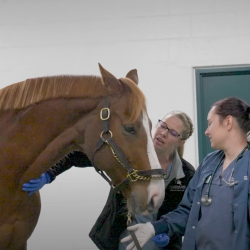History and Diagnosis
On Sunday, December 9, 2018, Lucky, a one-year-old mixed breed goat, presented to the Michigan State University Veterinary Medical Center’s Large Animal Clinic for straining and inability to urinate. According to his owners, the last time Lucky urinated normally was the previous day.
On examination, Lucky was quiet, alert, and responsive, but clearly uncomfortable. He was standing in a stretched-out position and often cried out in distress during his physical examination. Several small stones were noted on the prepuce, which were suspected to be uroliths, also known as urinary stones or urinary calculi.
Due to the suspicion of obstructive urolithiasis, also known as a blockage of his urinary tract, further diagnostic investigation was performed. An abdominal ultrasound found Lucky’s bladder to be enlarged, approximately 10–12 cm in diameter. Abdominal radiographs confirmed this, but no radiopaque stones could be identified in the bladder or urethra.
Lucky’s history, clinical examination, and diagnostic findings pointed to an obstructive urolithiasis and surgery was recommended. Lucky had an elevated heart-rate of 120 bpm compared to the normal parameters of 70–80 bpm for goats. His respirations also were elevated at 30 brpm compared to 12–20 brpm. Bloodwork was performed to assess the severity of disease and found minimal abnormalities. Thus, Lucky was determined to be a good candidate for emergency anesthesia and surgery (hyperkalemia was not present, therefore there was no risk of bradycardia or cardiac arrhythmias caused by that condition).
Treatment and Outcome: MSU Large Animal and Anesthesia and Pain Management Service
Prior to surgery, an intravenous catheter was placed in preparation for general anesthesia. An antimicrobial (ceftiofur sodium, 2.2 mg/kg IV) and an anti-inflammatory (flunixin meglumine, 1.1 mg/kg IV) also were administered. Lucky was placed under general anesthesia and his abdomen was clipped and aseptically prepared for surgery.
During surgery, an abdominal incision was made to access Lucky’s bladder. Urinary stones were removed from his bladder and had the appearance of struvite stones (amorphous magnesium calcium phosphate). His urethra was flushed with saline to remove the obstruction and a temporary tube cystostomy was performed. This entails placing a Foley catheter from his bladder and through his abdominal wall to drain urine and serve as a temporary bypass. Tube placement is still important in cases that become unobstructed at surgery because the inflammation and urethrospasm can still cause patients to have difficulty urinating in the immediate postoperative period.
Lucky recovered well from anesthesia. He remained in the Hospital for approximately one week after surgery to give his urethra time to heal. To ensure patency of Lucky’s urethra, the Foley catheter was closed for increasing intervals of time to “challenge” him to urinate normally on his own. Lucky passed this challenge uneventfully. During the postoperative period, Lucky continued his course of antimicrobial and anti-inflammatory therapy.
Comments
What: Urinary stone formation and obstructive urolithiasis or “being blocked” is an extremely common condition that can occur in male goats of all ages. In addition to not producing urine, other common signs of this condition include inappetence, self-imposed isolation, posturing or straining to urinate, and increased or decreased vocalization.
Common bloodwork abnormalities seen in these cases include azotemia (increased BUN and creatinine), hyperkalemia, and dehydration. It is imperative to assess the potassium level prior to anesthesia and surgery, as hyperkalemia can lead to bradycardia and cardiac arrhythmias that may be exacerbated by anesthesia.
Why: Although there are many factors leading to stone formation, diet plays a large role. Alfalfa and legume-type hays that are high in calcium lead to the formation of calcium carbonate and calcium-containing stones, which are radiopaque and easily viewed on a radiograph. Grain and pelleted diets often lead to the formation of struvite and struvite-like stones that are not easily viewed on a radiograph.
Treatment: Like Lucky, recommended treatment involves emergency surgical intervention to relieve the obstruction. Unlike cats, a urinary catheter cannot be passed along the entire length of the goat’s urethra and into the bladder due to the urethral diverticulum. This structure is present as the urethra courses over the pelvis to become the pelvic urethra. The urinary catheter will often lodge in this diverticulum and be unable to pass into the bladder.
There are multiple surgical procedures that can be performed; however, amputation of the urethral process (an appendage at the end of the penis that can get clogged with stones) in combination with a temporary tube cystostomy are often recommended. Other surgical options include modified perineal urethrostomy, vesicopreputial anastomosis, and bladder marsupialization. Choice of surgical treatment is based on multiple factors including intended use of the animal, location, and severity of the obstruction, previous history of urinary obstruction, systemic health status of the animal, and owner finances and expectations. Reported success rates for restoration of normal urinary flow following temporary tube cystostomy vary from 76–83 percent. A small number of goats (12–17 percent) will not become unobstructed following the initial tube cystostomy and after given time to allow urethrospasm and inflammation to subside. In this small population, a second surgical procedure may be required.
Prevention: Because diet is a major contributor to formation of urinary stones, dietary management is a key factor in prevention of this disease. Male goats should be fed a diet of timothy hay and fresh grass. Alfalfa and legume hays, grain, or pelleted diets are not recommended for male goats, as they can promote the formation of stones. Providing access to a white (sodium chloride) salt block (NOT a red mineral block) and clean, fresh water is also recommended.



